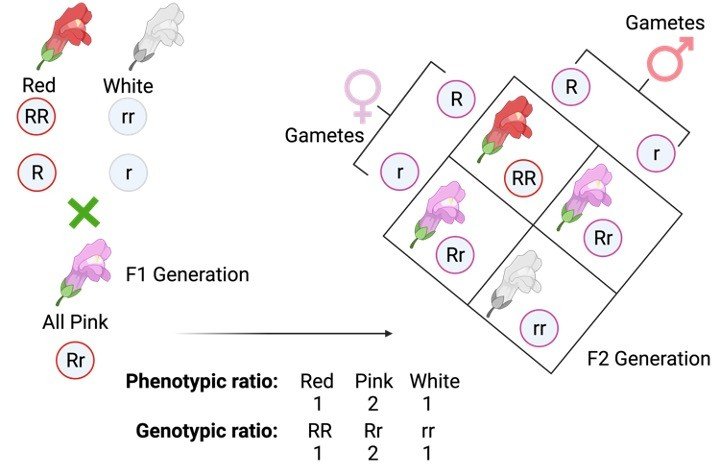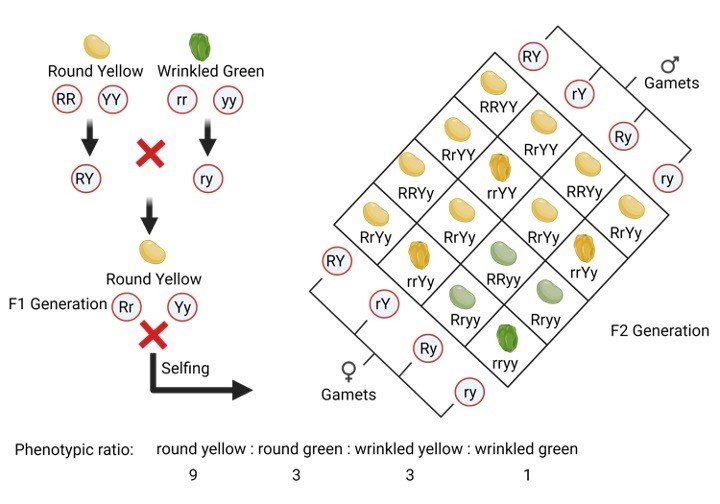Table of Contents
Mendel's Law of Segregation
Gregor Mendel, the pioneer of genetics, published his results in 1860, which were originally controversial at the time but gradually gained momentum and became so generally recognised that they opened the way for the science of genetics to be founded. Based on his experiments with pea plant reproduction, he developed three separate rules of inheritance. His research clarified how genetic characteristics are passed down from generation to generation.
These rules have substantially increased our understanding of genetic inheritance and led to the development of novel experimental methodologies. The following are three different Mendel inheritance laws:
• The Law of Segregation
• The Law of Independent Assortment
• The Law of Dominance
Law of Segregation Definition
It’s also known as the first law of inheritance. The segregation law stipulates that:
“During the formation of gametes, the two copies of each genetic component separate to guarantee that each parent’s offspring inherits one element.”
“During the gamete’s development, each gene is segregated such that the gamete only has one allele for that gene.”
When a person creates gametes, the copies of a gene are separated such that each gamete only receives one copy. A gamete receives only one allele.
As the mechanism of meiosis was better understood, the exact proof of this was uncovered. The mother’s and father’s genes are divided during meiosis, resulting in two unique gametes with different character alleles.
Allele vs Gene
An allele is a distinct version of a gene; a gene is an important portion of the DNA that specifies a certain characteristic. Genes have a crucial influence on the manifestation of characteristics. Alleles are significant because they influence how a characteristic can be manifested.
Mendel claimed that the determining elements of heredity are distinct “unit factors” (now termed genes) that keep their integrity from the moment the zygote is created until it grows and produces its own gametes, despite his lack of understanding of chromosomes. The components of these paired “unit factors” segregate from one another and produce distinct gametes during gamete development.
What is Law of Segregation?
During meiosis, segregation occurs when allele pairs (different characteristics of the same gene) are separated so that they may be transferred to distinct gametes.
One of the Mendelian Laws of Inheritance, the Law of Segregation, states that the two members of a pair of alleles separate during gamete production. As a result, each gamete only has one member of each gene pair. The Law of Gamete Purity is a synonym. Compare and contrast the laws of Independent Assortment, Dominance, and Unit Characters.
Why is mendel's law of segregation known as the gamete purity law?
The Law of Segregation in genetics states that a gamete can carry either a recessive or dominant allele, but not both at the same time. This is why the law of purity of gametes is also known as the law of gametes purity.
Mendel’s first law was the segregation law. According to this theory, alleles separate during meiosis, according to this theory. The following are the essential principles of this law:
• For a gene, there might be more than one type of allele.
• When gametes are produced during the meiosis process, the allele pairs segregate, or separate.
• Two alleles are involved in the determination of a Mendelian trait: one is recessive and the other is dominant.
They stay together in pure form even when they are not affecting one other. They don’t mingle or merge in any way. Because of this, the segregation law is also known as the law of gamete purity. The segregation of two alleles of a gene generally happens during the production of gametes due to the segregation of homologous chromosomes during meiosis. Sister chromatids of homologous chromosomes separate during anaphase II, while tetrads (each tetrad consists of four chromatids of a homologous pair that arises through synapsis) separate during anaphase I.
A gamete is a kind of cell that participates in fertilisation. In humans, the female and male gametes are the egg and sperm, respectively. The X chromosome is the only kind of sex chromosome found in human eggs. The X or Y chromosome can be found in human sperm cells. The sex of the child is determined by this. A gamete will get one of the two alleles for any feature, including dominant or recessive traits, under the segregation law.
Law of Segregation Examples
A Mendelian trait’s alleles can be dominant or recessive, and they can be passed down from parent to kid (animal or plant). The colour characteristics of the flowers in plants, for example, are determined by the kind of allele inherited by the children. One of the alleles is passed down to the offspring of each parent plant. And the offspring’s allele sets will be determined by the chromosomes of the two gametes joining during fertilisation. During gamete development, these two sets of chromosomes are randomly separated (wherein meiosis is a part of the process).

Gregor Mendel was able to come up with the fundamental principles of inheritance in his paper outlining his work on the breeding and study of thousands of garden peas, subsequently described as Mendel’s Laws of Inheritance. The Law of Segregation, the Law of Independent Assortment, the Law of Dominance, and the Law of Unit Characters are the four laws in question.
Law of Segregation Principle and Example
The concept of segregation states that each individual has two alleles for each trait, and these alleles become segregated throughout the formation of gametes. In other words, each gamete has just one allele. The idea of segregation is important because it defines how genotypic ratios in haploid gametes are formed.
What does it imply when an allele is dominant?
The dominant allele is the one that has a physical manifestation (visible) on the human body as a result of its dominance. They have an effect even if the individual just has one copy of the allele. For example, between the yellow-flower trait and the white-flower trait, the dominant trait is the one that will emerge in a hybrid offspring, and the dominant allele is the one that codes for that feature.
In the absence of the dominant allele, the recessive allele will be expressed. Thus, children carrying the dominant allele will show the dominant characteristic, such as yellow flowers, while those carrying the recessive allele will show the recessive trait, such as white flowers.
In meiosis, where does the law of segregation apply?
In anaphase (I and II) of meiosis, Mendel’s Segregation Law is observed. The homologous chromosomes are separated into two daughter nuclei with different variants of each gene during the first meiotic division. The activity of homologous chromosomes during meiosis can help to separate alleles into different gametes for every genetic locus. The two distinct alleles for a single gene typically segregate when chromosomes divide into numerous gametes during meiosis, with each gamete acquiring one of the two alleles.
Why is the law of segregation so universally recognised?
The Law of Segregation is a widely acknowledged inheritance law since it is the only one that does not contain any exceptions, although the other two laws do. It claims that during fertilisation, each gene, which consists of two alleles that vary throughout the formation of gametes, one allele from both the mother and father, unites.
Law of Independent Assortment
It is also known as the second inheritance law, and it states:
“Separate allele pairs are handed right down to the next generation separately from one another, As a result, gene inheritance at one point within the genome has no pertaining to gene inheritance elsewhere”.
“Alleles of varied genes that are distributed during gamete production assort independently of one another, consistent with this rule.”
This law applies to qualities that are unrelated to one another, such as seed colour and form. When a person inherits two or more traits, they are assorted individually throughout the gamete formation process. As a result, the diverse characteristics have an equal chance of happening together. This means that one character’s inheritance will have no bearing on the inheritance of the other.
What is Law of Independent Assortment?
One pair of Mendelian traits differs from the other pair when two sets of Mendelian traits are merged into a hybrid. As a result, the alleles are self-contained and have no effect on the other alleles. For example, a round and yellow-shaped pea plant was cross-pollinated with a wrinkled green-shaped pea plant.
When does Law of Independent Assortment take place?
During metaphase I and anaphase I of meiosis, separate assortment laws may be seen while crossing over occurs in Prophase I. In metaphase, for example, the chromosomes line up in a random order along the metaphase plate.
Gamete cells are the end result of meiosis. Haploid cells, which have half the DNA of diploid cells, are known as gamete cells. It is a crucial element of reproduction that allows gamete cells to unite to create a diploid zygote, which has the DNA information needed for child development and the chromosomal number that is maintained over generations.
Principle of Independent Assortment
Independent assortment principles state that allele pairs are separated during gamete development, implying that characteristics are handed down to offspring independently of one another.
Law of Independent Assortment Importance
It’s crucial for various genetic variants in organisms. During the formation of gametes, for example, the gene or alleles coding for one trait segregate separately from the gene or alleles coding for another trait. It is also necessary for the generation of new genetic variants that increase population genetic diversity.
Law of Independent Assortment and Law of Segregation
• In the Mendelian inheritance pattern, both of them play a role.
• Both the first and second rules of Mendel shed light on the inheritance of alleles.
• Both laws are beneficial in expanding the diversity of individuals within communities.
Law of Independent Assortment and Law of Segregation
Mendel’s Segregation Law states that during gamete formation, two copies of each genetic component are different from one another. The law of segregation defines non-homologous chromosomal activity.
When two or more variables are inherited, the Independent Assortment law states that during the generation of gametes, an individual’s genetic factors assemble independently. This rule governs the action of alleles.
Mendel’s Law of Dominance
According to Mendel’s Law of Dominance:
“In a cross of parents who are pure for several characteristics, only one kind of trait will show up within subsequent generation. Offspring that are hybrid for a trait will show just the dominant trait, whereas children who are not hybrid would show recessive traits”.
“One component of a pair of characteristics dominates in inheritance while the other is repressed unless both variables in a pair are recessive. In the next generation of parents, there will only be one type of trait that is pure for contrasting features”.
What is Mendel’s Law of Dominance?
The silenced recessive allele will remain “dormant.” It will, however, be passed on to the following generation in the same manner as the dominant allele is. Only progenies with two copies of the repressed allele will express the suppressed characteristic.

When crossed by themselves, these children can also breed true. When Mendel crossed his pea plants numerous times, he discovered that when he crossed both pure tall and short plants, all young pea plants (F1) were tall. Yellow-seeded pea plants (F1) were made by crossing pure yellow-seeded and green-seeded pea plants.
Human Characteristics
There are about 200 characteristics that are passed down from generation to generation in humans. Hereditary characteristics are the names given to these intriguing aspects of human genetics. Dominant and recessive characteristics are among these genetic traits.
Dominant Characteristics
• The dominant trait is the one that emerges earliest or is most clearly displayed in a person.
• Dwarfism, high blood pressure, baldness (in men), abundant body hair, and six fingers are examples.
• Capital letters, such as AA or BB, denote a dominating characteristic.
Recessive Characteristics
• A recessive characteristic is one that is present at the genome level but is concealed and does not manifest in the organism.
• Normal development, normal blood pressure, not bald, minimal body hair, and normal five fingers are some examples.
• Small letters, such as aa or bb, are used to denote recessive traits.
A human’s physical, emotional, psychological, and health traits are all influenced by gene expression. Parents’ genes are handed on to their children.
Why can't these mendelian laws be applied universally?
Because certain characteristics do not follow Mendel’s inheritance pattern, the laws of independent assortment and dominance regulating inheritance are not always relevant. Non-Mendelian characteristics are those that are not Mendelian. Polygenic inheritance or numerous alleles, codominance, and incomplete dominance are examples of such characteristics.
Because certain alleles tend to be inherited jointly, the law of independent assortment is not always applicable. Sex-related characteristics are an example. They explain why some characteristics are shared by both men and women.
When chromosomes were discovered, Mendel’s hypothesis was confirmed, and meiosis was thoroughly defined in the years that followed. If the genes were on chromosomes, the two members of the pair would split during Anaphase I of meiosis as the homologous chromosomes migrate apart from each other toward the opposing ends of the dividing cell.
Importance of Mendel's Laws in Biology
Mendel’s rules are useful in plant and animal breeding because they allow for the production of desired varieties of plants and animals through hybridization. The required traits conveyed in various combinations can be linked and preserved in a single unique variety.
Because of Mendel’s segregation law and independent assortment law, cross hybridization has resulted in the development of numerous new disease-resistant and high-yielding agricultural products and ornamental plants.
Law of Segregation Citations
- Statistics of Mendelian segregation-A mixture model. J Anim Breed Genet . 2019 Sep;136(5):341-350.
- On the origins of the Mendelian laws. J Hered . Jan-Feb 1984;75(1):67-9.
- Limits of imagination: the 150th Anniversary of Mendel’s Laws, and why Mendel failed to see the importance of his discovery for Darwin’s theory of evolution. Genome . 2015 Sep;58(9):415-21.
Share












